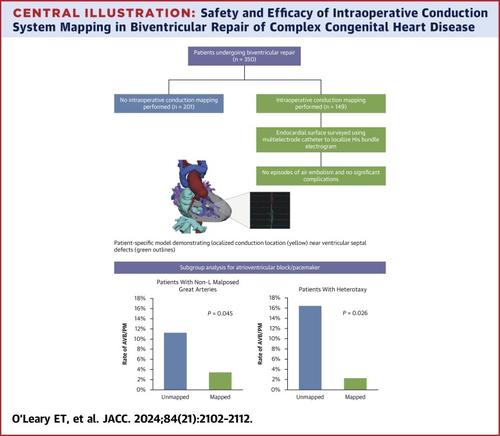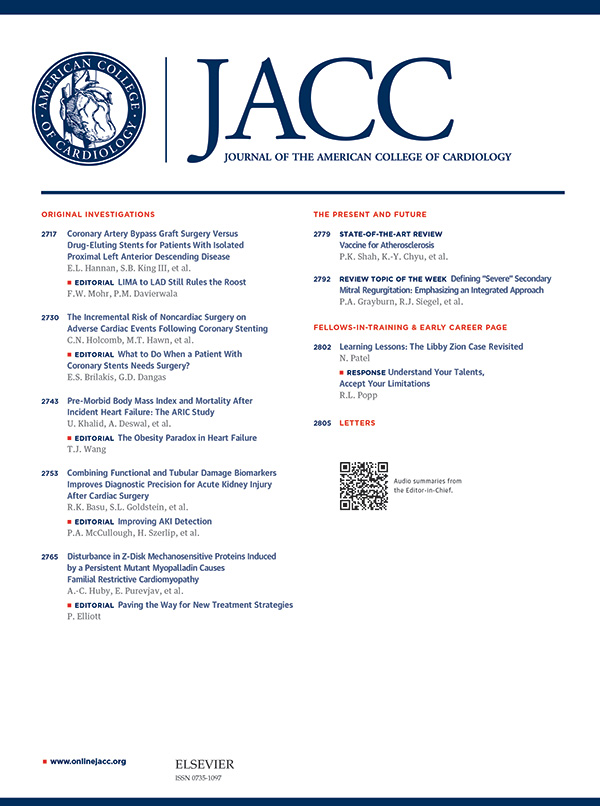绘制术中传导图以减少复杂先天性心脏病术后房室传导阻滞
IF 21.7
1区 医学
Q1 CARDIAC & CARDIOVASCULAR SYSTEMS
引用次数: 0
摘要
背景术后需要起搏器的房室传导阻滞(AVB/PM)并发症占复杂先天性心脏病(CHD)双心室修复手术和异位综合征患者的 14% 至 25%。本研究旨在评估在复杂的双心室 CHD 修复手术中能否安全地进行术中 His 束(HB)映射,并减少术后 AVB/PM。方法使用市售的多电极网格导管对 2019 年至 2022 年期间接受双心室修复手术的复杂 CHD 患者进行 HB 映射,并与未映射的队列进行比较。主要结果是术后 AVB/PM。结果 149 名患者接受了 HB 映射,而未接受映射的对照组为 201 人。映射患者的中位年龄为 1.9 岁(Q1-Q3:0.9-3.9 岁)。31%的患者(149 例中的 46 例)存在异位综合征,95%的患者(149 例中的 142 例)存在室间隔缺损,68%的患者(149 例中的 89 例)曾接受单心室姑息治疗。97%的病例(149 例中的 144 例)确定了 HB。中位绘图时间为 6 分钟。术中未发生系统性空气栓塞。术后 AVB/PM 发生率在有异位(2% [n = 46 例中的 1 例] vs 16% [n = 67 例中的 11 例];P = 0.026)和无 L 型大动脉(3% [n = 88 例中的 3 例] vs 11% [n = 134 例中的 15 例];P = 0.045)的映射患者中明显降低。结论在接受复杂双心室修复术(包括异位综合征和非 L 假体大动脉)的特定人群中,可以安全地进行术前 HB 图谱绘制,并能显著减少术后 AVB/PM。尽管如此,某些亚群仍有发生房室传导阻滞/房室传导阻滞的风险,这表明目前的术中 HB 测绘技术和技巧需要进一步改进。本文章由计算机程序翻译,如有差异,请以英文原文为准。

Intraoperative Conduction Mapping to Reduce Postoperative Atrioventricular Block in Complex Congenital Heart Disease
Background
Postoperative atrioventricular block requiring pacemaker (AVB/PM) complicates 14% to 25% of biventricular repair operations for complex congenital heart disease (CHD) and in those with heterotaxy syndrome.
Objectives
This study aimed to evaluate if intraoperative His bundle (HB) mapping during complex biventricular CHD repair can be performed safely and reduce postoperative AVB/PM.
Methods
HB mapping was performed using a commercially available multielectrode grid catheter in patients with complex CHD undergoing biventricular repair between 2019 and 2022 compared with an unmapped cohort. The primary outcome was postoperative AVB/PM.
Results
One hundred forty-nine patients underwent HB mapping compared to 201 unmapped controls. The median age of mapped patients was 1.9 years (Q1-Q3: 0.9-3.9 years). Heterotaxy syndrome was present in 31% (n = 46 of 149), ventricular septal defect in 95% (n = 142 of 149), and prior single ventricle palliation in 68% (n = 89 of 149). The HB was identified in 97% (n = 144 of 149) of cases. The median mapping time was 6 minutes. No episodes of intraoperative systemic air embolism occurred. Postoperative AVB/PM frequency was significantly reduced in mapped patients with heterotaxy (2% [n = 1 of 46] vs 16% [n = 11 of 67]; P = 0.026) and in patients without L-malposed great arteries (3% [n = 3 of 88] vs 11% [n = 15 of 134]; P = 0.045).
Conclusions
Intraoperative HB mapping can be performed safely and is associated with significantly reduced postoperative AVB/PM in select populations undergoing complex biventricular repair, including heterotaxy syndrome and non–L-malposed great arteries. Nonetheless, certain subgroups remain at risk for AVB/PM, showing the need for further improvements to current intraoperative HB mapping technology and techniques.
求助全文
通过发布文献求助,成功后即可免费获取论文全文。
去求助
来源期刊
CiteScore
42.70
自引率
3.30%
发文量
5097
审稿时长
2-4 weeks
期刊介绍:
The Journal of the American College of Cardiology (JACC) publishes peer-reviewed articles highlighting all aspects of cardiovascular disease, including original clinical studies, experimental investigations with clear clinical relevance, state-of-the-art papers and viewpoints.
Content Profile:
-Original Investigations
-JACC State-of-the-Art Reviews
-JACC Review Topics of the Week
-Guidelines & Clinical Documents
-JACC Guideline Comparisons
-JACC Scientific Expert Panels
-Cardiovascular Medicine & Society
-Editorial Comments (accompanying every Original Investigation)
-Research Letters
-Fellows-in-Training/Early Career Professional Pages
-Editor’s Pages from the Editor-in-Chief or other invited thought leaders

 求助内容:
求助内容: 应助结果提醒方式:
应助结果提醒方式:


